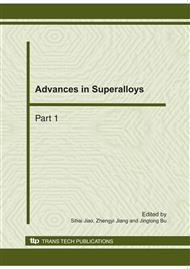[1]
S. Song and G. T. Gray III: Metall. Mater. Trans. A Vol. 26 (1995), p.2665.
Google Scholar
[2]
Y. -W. Kim: JOM Vol. 46 (1994), p.30.
Google Scholar
[3]
W. T. Marketz, F. D. Fischer and H. Clemens: Int. J. Plast. Vol. 19 (2003), p.281.
Google Scholar
[4]
D. Shechtman, M. Blackburn and H. Lipsitt: Metall. Trans. Vol. 5 (1974), p.1373.
Google Scholar
[5]
F. Appel and R. Wagner: Mat. Sci. Eng. R Vol. 22 (1998), p.187.
Google Scholar
[6]
J. Kumpfert, Y. W. Kim and D. M. Dimiduk: Mat. Sci. Eng. A Vol. 192-193 (1995), p.465.
Google Scholar
[7]
C. T. Liu: Materials Chemistry and Physics Vol. 42 (1995), p.77.
Google Scholar
[8]
M. Yamaguchi, H. Inui, S. Yokoshima, K. Kishida and D. R. Johnson: Materials Science and Engineering: A Vol. 213 (1996), p.25.
Google Scholar
[9]
F. Appel, U. Brossmann, U. Christoph, S. Eggert, P. Janschek, U. Lorenz, J. Müllauer, M. Oehring and J. D. H. Paul: Adv. Eng. Mater. Vol. 2 (2000), p.699.
DOI: 10.1002/1527-2648(200011)2:11<699::aid-adem699>3.0.co;2-j
Google Scholar
[10]
H. Clemens and H. Kestler: Adv. Eng. Mater. Vol. 2 (2000), p.551.
Google Scholar
[11]
Y. -W. Kim and D. M. Dimiduk: JOM Vol. 43 (1991), p.41.
Google Scholar
[12]
Z. Jin, C. Cady, G. T. Gray III and Y. -W. Kim: Metall. Mater. Trans. A Vol. 31 (2000), p.1007.
Google Scholar
[13]
S. A. Maloy and G. T. Gray III: Acta Mater. Vol. 44 (1996), p.1741.
Google Scholar
[14]
Z. M. Sun, T. Kobayashi, H. Fukumasu, I. Yamamoto and K. Shibue: Metall. Mater. Trans. A Vol. 29 (1998), p.263.
Google Scholar
[15]
Y. M. Xia and Y. Wang: J. Test. Eval. Vol. 35 (2007), p.1.
Google Scholar
[16]
X. Zan, X. Chen, W. Huang and Y. Xia: J. Exp. Mech. Vol. 20 (2005), p.321.
Google Scholar
[17]
V. M. Imayev, R. M. Imayev, G. A. Salishchev, K. B. Povarova, M. R. Shagiev and A. V. Kuznetsov: Scr. Mater. Vol. 36 (1997), p.891.
Google Scholar
[18]
R. Reed-Hill and R. Abbaschian: Physical Metallurgy Principles. (PWS-Kent, USA 1992).
Google Scholar
[19]
M. A. Meyers, O. Vohringer and V. A. Lubarda: Acta Mater. Vol. 49 (2001), p.4025.
Google Scholar


